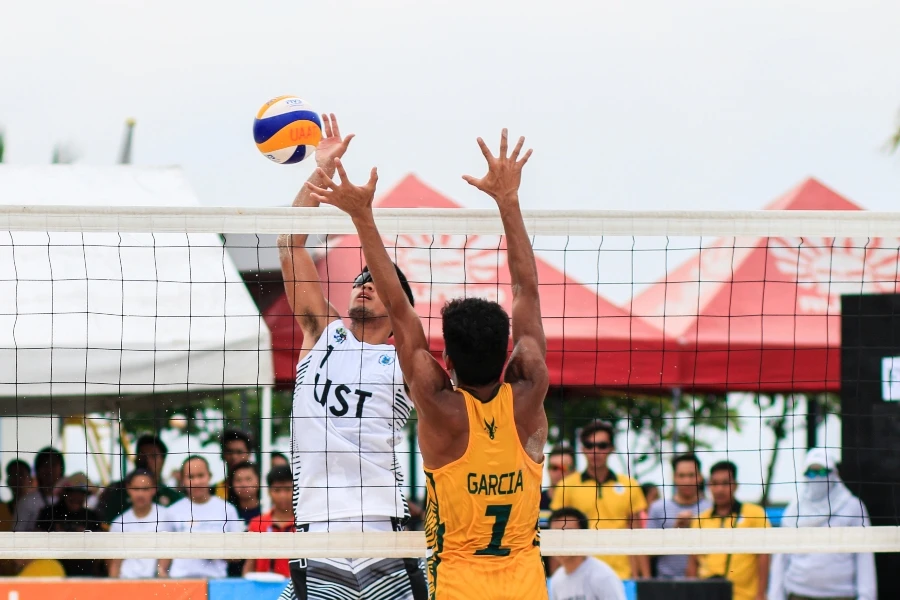Volleyball is one of the most exciting games because you can play it on or off a conventional court. This is why you see people play the game, even on the beaches and in any place. The game is played by two teams, with each team comprising 6 players. The players use their hands in batting the ball back and forth over a high net. A team scores a point if the ball hits the ground on the opponent’s side of the net.
So how is a Block Used in Volleyball
Block is used in volleyball to prevent an opponent from an attack hit.
Block Terms Used In Volleyball
Blocking in volleyball is deflecting that ball coming from the opposing team. There are several other terms used in blocking worth knowing;
1. Blocking
This is a skill in volleyball used in deflecting the ball coming from an attacker. Blocking helps you prevent a successful attack hit from the opponent.
The main objective of the blocker is to block the ball back into the opponent’s side. Volleyball teams often develop different block skills to achieve their aims. For instance, a team may use a blocker to take up space, and the rest of the defensive players will take the remaining space on their side of the court that the blocker is not defending.
In some other cases, an advance blocker will try to deflect the ball to their teammates to keep it alive until they launch it into the opponents’ half.
2. Block Assist
The block assist is given when two or more players participate in a successful block simultaneously. It is also referred to as a collective one.
3. The Double Block
A double block is when two blocks work together to deflect an attack ball from the opponent at the net. Putting up a double block is always a great strategy, and you must do it as quickly as possible to prevent a successful attack from the opponent.
4. The Tripple Block
The triple block is when three players jump at the same time at the net to block a ball from the ball coming from the opponent. A team that puts up a triple block at the net may find it difficult to block a ball successfully. Since each team in a volleyball match has three players that can attack by the net, it becomes difficult for blockers to get in the correct position to put a triple block since they don’t know who is launching the attack.
5. The Weak Side Blocker
The weak side blocker is often a front player that blocks the balls coming towards the left side of the volleyball court. In most cases, the team’s left side is often considered the weakest point and often regarded as the most challenging area to protect in volleyball.
6. Middle Blocker
The middle blocker is the one who moves from the middle of the net to block shots from the opponents. The person who plays as the middle blocker is often the tallest because they have to defend against the middle and outside hitters. The middle blocker is one of the most active players on the team as they have to move back and forth to and from the middle of the net to block shots.
7. The Strong Side Blocker
The strong side blocker is the one that blocks shots from the opponents that are towards the right side of the court. The opponent’s best hitters often hit out from the strongest side, which is often the right side. Most teams often put their best hitters on their strong sides, and they do that to defend against the opponents’ best hitters.
8. The Offside Blocker
The offside blocker is positioned at the net farther away from the opponent hits. The offside blocker often pulls out the net to defend the opponent’s attacks or prepare to take an approach to hit the ball against the opponent.
9. Closing a Block
Closing the block involves an assist blocker joining a primary blocker and putting the best resistance against hits from the opponents. It is also called block sealing because the ball can’t penetrate through the barrier created by the two blockers.
10. The Joust
A joust is when two opponents are in contact with the ball simultaneously, above the net. This should not stop the play, and it is not a foul.
11. Net Penetration
Net penetration is a term used to describe when a player reaches above the net during an attack or a block.
12. Turning In
The turn-in is an act where an outside blocker turns their body to face the opponent’s side of the court to ensure that a blocked ball is deflected towards the opponent.
13. Getting Stuffed
Getting stuffed is a term used in describing a situation where a blocker blocks the ball down to the floor just as hard as it was hit by the opponent. A stuffed block is also referred to as a situation where the ball spins off the block into the face or any other body part of an attacker. Stuffed shots are often referred to as the roof
14. The Fish
A player is often referred to as fish when they are caught up inside the net. This is a violation of the game, and it is often referred to as tuna.
Improving Your Volleyball Skills- Tips And Ideas From Professionals
There are several ways you can improve on your volleyball skills, especially in attack. Here are a few tips and ideas to keep in mind;
1. Skills to Attack at the Net
Developing consistent footwork perhaps is one of the best ways to attack at the net. You can take the three or four-step approach. The three-step approach for the right-hand attacker, for instance, could be the left , then right and left step technique. Practising this stepping technique can help you maintain consistency when approaching attacks from opponents.
It would be best if you also learned to approach quickly. It would be best if you learned to step forward quickly to jump as high as you can. Stepping quickly helps maximize your height. It would be best if you also learned to swing your arms back as an attacker. With backward arm swinging, you can take advantage of your elastic energy plus your nervous system, and this allows you to stretch your reflex, a condition that can add a few inches to your vertical position.
It would be best if you also learned to raise both hands up when blocking or attacking. Taking both your hands up, especially when jumping, can help you sustain the momentum upwards. Keeping your hands up can also help you maximise your height, which is important in blocking or attacking. With your hands up, you will likely have a better position to hit your opponent.
Learn to contact the ball in front of the hitting shoulder. It is always a great idea to contact the ball at the same spot each time you hit. Doing this will help you develop a consistent arm swing. Similarly, it would be best if you learned to put your topspin when you hit the ball; this will help you have better hitting angles and more space on your opponent’s court to hit. It is a technique referred to as strapping the wrist when contacting the ball.
2. Tips for Better Blocking
To become a better volleyball blocker, you need to have a better view of the volleyball court to help you make better judgments, see the setter, and hitters, and the ball more clearly.
When you have a better court vision, you will predict almost accurately where the setter will hit the ball on your side of the court. Good vision helps you monitor the ball’s movement when it is passed.
The better you can judge where the ball is being passed, the better your chances of predicting where the setter will place the ball. Having good visual contact with hitters and setters will help you discover where to block in less time.
It is also important that you identify the front-row players. If you are a blocker, you must identify the strength and weaknesses of your opponent’s front-row players even before they serve.
You may want to learn the shuffle step technique alongside having good vision and identifying the front row players. With the shuffle step technique, you can ensure that your hips remain squared to the net. This is a great posture for better blocking and serving.
The crossover step technique is another technique you may want to learn. This technique may be slightly harder because you have to turn your body, especially the hips, while you move. You have to return to your squared position before the net just before you jump.







